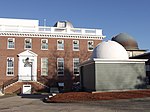Harvard College Observatory

The Harvard College Observatory (HCO) is an institution managing a complex of buildings and multiple instruments used for astronomical research by the Harvard University Department of Astronomy. It is located in Cambridge, Massachusetts, United States, and was founded in 1839. With the Smithsonian Astrophysical Observatory, it forms part of the Harvard–Smithsonian Center for Astrophysics. HCO houses a collection of approximately 500,000 astronomical plates taken between the mid-1880s and 1989 (with a gap from 1953–1968). This 100-year coverage is a unique resource for studying temporal variations in the universe. The Digital Access to a Sky Century @ Harvard project is digitally scanning and archiving these photographic plates.
Excerpt from the Wikipedia article Harvard College Observatory (License: CC BY-SA 3.0, Authors, Images).Harvard College Observatory
Martin Street, Cambridge
Geographical coordinates (GPS) Address Nearby Places Show on map
Geographical coordinates (GPS)
| Latitude | Longitude |
|---|---|
| N 42.3815 ° | E -71.1284 ° |
Address
Harvard University
Martin Street
02138 Cambridge
Massachusetts, United States
Open on Google Maps










